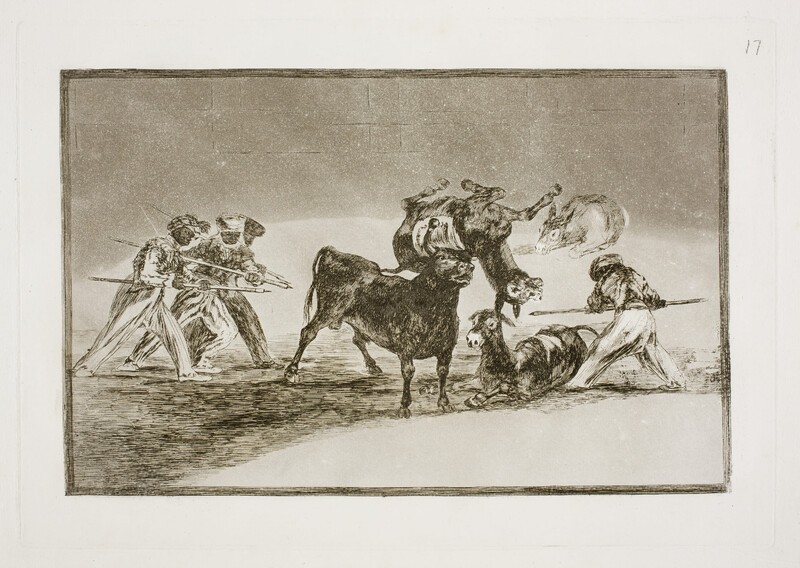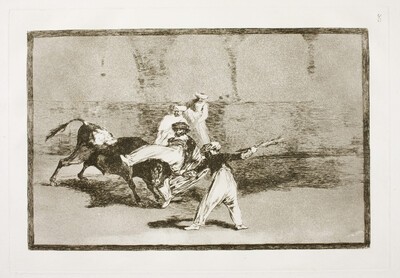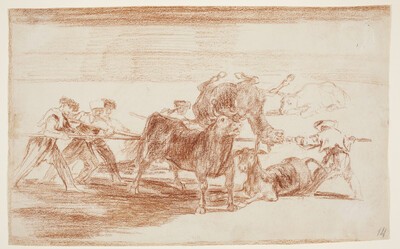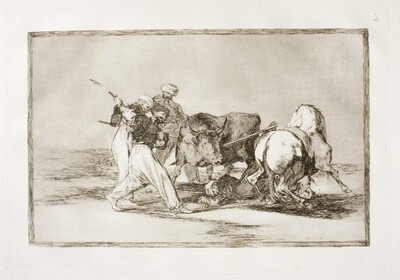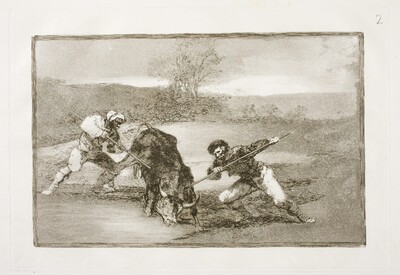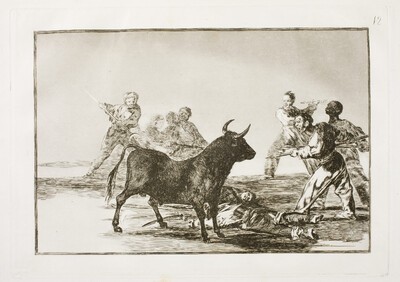- Cronología
- 1814 - 1816
- Dimensiones
- 244 x 353 mm
- Técnica y soporte
- Aguafuerte, aguatinta, punta seca, buril y bruñidor
- Reconocimiento de la autoría de Goya
- Documented work
- Ficha: realización/revisión
- 01 Oct 2021 / 22 Jun 2023
- Inventario
- -
17 (print, upper right-hand corner)
See How the ancient Spaniards hunted bulls on horseback in the countryside
A state proof of this print before aquatint and burnisher is preserved in the Dutuit Collection, Musée du Petit Palais, Paris (Dut. 5387).
The plate is kept in the Calcografía Nacional (no. 350) and has The Death of Pepe Illo (Bullfighting F) engraved on the reverse.
See How the ancient Spaniards hunted bulls on horseback in the countryside
The scene is, as in the case of the previous print, very dark, with the bull in the centre of the picture, who carries a donkey between his horns and is surrounded by a group of bullfighters and donkeys. The light and shade emphasises the drama of the struggle between man and beast and adds nuance to the dramatic tension of the scene. The three figures on the left, no doubt Moors, are dressed as Mamluks and hold pikes with which they intend to wound the bull. On the other side of the composition, on the right, another Moor points his spear at the bull. But there are also three donkeys, one of which is almost at the back of the scene, as it has probably moved away from the bull or has been charged by the bull and is lying there. The scene can be set in a bullring, given that in the background of the scene we can see a hint of the barrier that surrounds the ring.
In this picture Goya depicts a rather cruel variety of the fiesta, consisting of placing a series of donkeys in front of the bullfighters so that they are protected from the bull's charge, which they attack with pointed spikes. This type of action, known as mojigangas, was a bullfighting custom in Goya's Madrid. However, José de Vargas Ponce, who was a contemporary of Goya's, notes that in Aragon there was the palenque, a type of bull running with a bull, to which ten or twelve young bullfighters are presented with sticks topped with iron spikes, who charge the animal as it comes out of the bullring and then kill it. Goya depicts something like this in this engraving, which because of its harshness can be related to others of bullfighting in which the bull is harassed with pikes or lances, such as How the ancient Spaniards hunted bulls on horseback in the countryside, Another way of hunting on foot or The Moors settled in Spain, disregarding the superstitions of their Alcoran, adopted this hunting and art, and they throw a bull in the field.
Martínez-Novillo believes that Goya depicted this print at the same time as Disembowelment of the rogue with spears, crescent moons,banderillas and other weapons, and as a transitional theme between the historical and contemporary scenes of Bullfighting. In fact, in both engravings, we find characters of the same type, those destined to disjarretar the bull cited by Nicolás F. de Moratín: Moorish slaves, then [...] blacks and mulattos.
The print is part of the subgroup, within the group of "historical" scenes of Bullfighting (Nos. 1-11), dedicated to the bullfighting of the Moors (Nos. 3-8 and 17) , although Goya may have been inspired by bullfights held in Madrid during the time of Joseph Bonaparte in which Mamluk soldiers (Egyptian Muslims who formed part of the Napoleonic armies) took part.
There is a preparatory drawing for this print, also entitled Moorish palenque made with donkeys to defend themselves from the bull on a stake
-
Grabados y dibujos de Goya en la Biblioteca NacionalBiblioteca NacionalMadrid1946catalogue Elena Páez Ríos
-
Goya en la Biblioteca Nacional. Exposición de grabados y dibujos en el sesquicentenario de su muerteBiblioteca NacionalMadrid1978May - June 1978
-
Grabados de Goya: colección propiedad de la Biblioteca Nacional, que se conserva en su Gabinete deCasa de la Amistad de MoscúMoscow1979exhibition displayed from January 18th to 31st 1979
-
1984
-
Madrid1987
-
Madrid1990
-
Goya grabadorFundación Juan MarchMadrid1994consultant editors Alfonso E. Pérez Sánchez and Julián Gállego, from January 14th to March 20th 1994
-
Goya grabadorMuseo del Grabado Español ContemporáneoMarbella1996from March 8th to May 5th 1996
-
Zaragoza1996
-
Ydioma universal: Goya en la Biblioteca NacionalBiblioteca NacionalMadrid1996from September 19th to December 15th 1996cat. 272
-
Schlaf der Vernunft. Original radierungen von Francisco de GoyaMunich2000
-
Madrid2002
-
Madrid2002
-
Goya en tiempos de guerraMuseo Nacional del PradoMadrid2008consultant editor Manuela B. Mena Marqués, from April 14th to July 13th 2008cat. 149
-
Bilbao2012
-
Zaragoza2017
-
1946pp. 177-216, espec. pp. 197-198
-
BarcelonaTartessos-F. Oliver Branchfelt1946 (reed. 1951)
-
1961pp. 120-127
-
OxfordBruno Cassirer1964vol. II, 1964, p. 332, cat. 220
-
Vie et ouvre de Francisco de GoyaParísOffice du livre1970p. 278, cat. 1184
-
The Changing image: Prints by Francisco GoyaBostonMuseum of Fine Arts1974p. 225, cat. 177
-
MilwakeeMilwaukee Art Museum1986pp. 24 y 32
-
Goya, toros y torerosMadridMinisterio de Cultura, Comunidad de Madrid1990p. 100, cat. 32
-
MadridCaser-Turner1992p. 31
-
Catálogo de las estampas de Goya en la Biblioteca NacionalMadridMinisterio de Educación y Cultura, Biblioteca Nacional1996cat. 338
-
Ydioma universal: Goya en la Biblioteca NacionalMadridBiblioteca Nacional, Sociedad Estatal Goya 96 y Lunwerg1996p. 246
-
MadridMuseo Nacional del Prado2001pp. 68-70
-
MadridMuseo Nacional del Prado y Ediciones El Viso2008pp. 422-423, cat. 149
-
Goya. In the Norton Simon MuseumPasadenaNorton Simon Museum2016pp. 186-201
